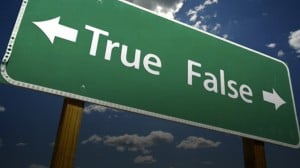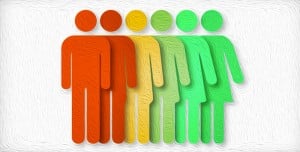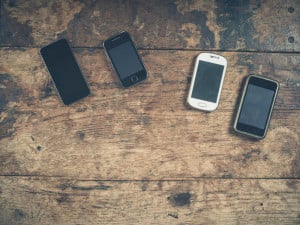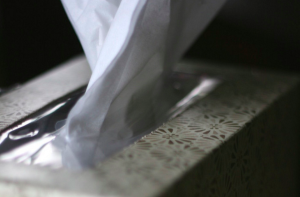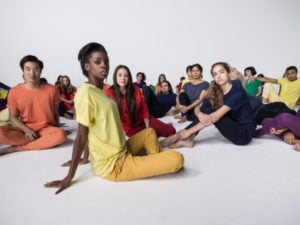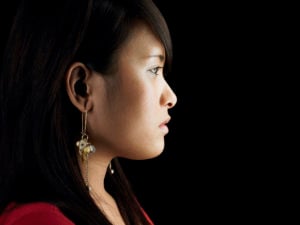
Profile of someone on a black background. They have long black hair, dangling gold earrings, and a serious expression.
I am Asian American and I hate teaching Asian American Studies. I’ve been doing it for about 5 years now and I regret to say it’s one of the most harrowing and downright painful experiences I repeatedly endure.
Is it because I hate my own kind? Absolutely not.
It’s because I frequently find that my students say some problematic, frightening, and downright erroneous things to resist seeing themselves as people of color who are oppressed. These include but are not limited to the following:
“No one’s ever been racist toward me.”
“It’s not like we’re Black.”
“We haven’t experienced racism in this country.”
“It’s worse in my home country.”
…or my least favorite and the inspiration for this article,
“We’re basically white.”
All of these things are untrue. Well, except for the second one because, unless you’re mixed race, we’re definitely not Black. That being said, I get it.
When I was younger, I saw Chinese folks who had nice houses, good educations, who spoke fluent English. And I saw Black folks who lived with the dehumanizing effects of anti-black racism.
Between those examples and Asian stereotypes, I thought, well yeah, maybe we’re just like white people.
Maybe if I work really hard, I can make it, too.
I bought into all the nonsense Asian Americans are taught to believe about our identities, our histories and our present in this country. I rejoiced when called a “twinkie” or a “banana” (white on the inside, yellow on the outside).
I thought because the racism I knew was different from the kind my Latinx and Black friends were familiar with, that it wasn’t legitimate. Wasn’t real. Wasn’t that bad.
Yet while our experiences as Asian Americans differ from other groups, we — like all other people of color in the United States — live with the daily ramifications of white supremacy. And that distinguishes us from white America.
I generally use the following equation to define racism:
Racism = power + prejudice
There are a tons of ways to define prejudice including but not limited to: cognitive, emotional or behavioral; you can read more about that here.
But prejudice alone doesn’t constitute racism. It’s also power: formal, institutional and material power.
An example would be the difference between a single person calling someone a Jap and the internment of Japanese Americans. The former is an act perpetrated by an individual while the latter is the state (or government) facilitated mass incarceration of an entire community based on race.
If we use the above equation it becomes clear that all Asian Americans experience racism because we experience these two things: prejudice and oppression from systems of power, together.
Now why do I want to point this out? Isn’t ignorance bliss? In a way it would be wonderful for all of us to erroneously think we’re immune to racism and that in fact we’re so close to whiteness socially and structurally it really doesn’t matter.
But if we continue along this route, we’re 1) simply wrong (in countless ways that I’m about to illustrate with this list) and 2) allowing ourselves to be divided from communities of color working toward equality both for us Asian Americans specifically and racial justice more generally.
So are you with me, beautiful community? Here’s how America was and continues to be racist against Asian Americans, and I’m not just talking about gross white dudes who are only into dating Asian women.
1. American Law and Foreign Policy Have Forcibly Excluded and Colonized Us
The very first law limiting immigration based on race was aimed at — you guessed it — Asians, Chinese folks more specifically.
The policy was called The Chinese Exclusion Act and it was a signed into United States federal law in 1882. It was exactly what it sounds like, a law that barred Chinese people from entering the United States.
Why?
Because Americans blamed high levels of unemployment and declining wages on Chinese workers — and don’t worry, you’re not alone if you think this sounds familiar to an argument we’re currently having about borders and a different migrant community. #MakeAmericaRacistAgain
The Chinese Exclusion Act was followed by countless other American policies restricting Asian immigration.
The Page Act barred “undesirables” generally, and Chinese women specifically, because they were assumed to be “prostitutes”.
Then there’s my all time favorite, the Asiatic Barred Zone Act that limited immigration from a broad part of the Asian continent because we were (get ready for this) “homosexuals,” “idiots,” “feeble-minded,” “criminals,” “epileptics,” “insane,” alcoholics,” “mentally or physically defective,” “polygamists,” and “anarchists.”
It further prevented illiterate people from immigrating to the US, let alone vote, which means the same literacy battles that we’re fighting when it comes to voting in southern and rural Black communities, Asian folks also fought and continue to fight.
Wait, there’s more.
Jason Kim Ph.D states “if there is one thing that unites all Asians, it’s the way America has used us to increase its own political power.” This fact is exemplified by the land wars America has waged across Asia.
The American War in Vietnam killed estimates of up to 4 million people in that peninsula alone and an additional 1 million in the region.
The Korean War took up to 3 million lives.
And just this year, the legacy of colonialism in the Philippines allowed the U.S. government to install five new military bases in the archipelago.
Racism in Asia and against Asian Americans has deep American roots that affect our communities to this very day.
2. Current American Laws Discriminate Against Us
Have you ever wondered why most Asian countries are impoverished with huge gaps between the rich and the poor, yet Asians in America seem to do so well? Wonder no more!
America has a habit of cherry picking only highly skilled technical workers to come to its shores. Immigration policies like H1B1 visas legalize preferences for only the most formally educated Asians to come to the United States.
In former presidential candidate Senator Marco Rubio’s words, an extension of H1B1 visas opens the gates for only “the smartest, hardest-working, most talented people on this planet.” The bias is so slanted that Rubio added, “I have no fear that this country is going to be overrun by Ph.D.s.”
At the same time, it’s difficult for poor Asians to immigrate and be successful in the United States. The Obama Administration has deported upwards of 250,000 Asian people who are parents and children. These folks often work for little to no pay, contrasting the model minority myth.
Asians who legally immigrate can be strikingly different from Asian folks in Asia. They’re a deliberately skewed population of the best and the brightest.
3. We’re Never On TV
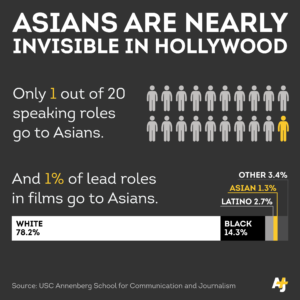
“Asians are nearly invisible in Hollywood. Only 1 out of 20 speaking roles go to Asians. And 1% of lead roles in films go to Asians.” Source: AJ+
With the stunning exception of ABC’s Fresh Off the Boat, Asians are almost never on screen, let alone in starring roles.
Fresh Off the Boat is the first time we’ve seen an entire Asian American family starring in a sitcom since Margaret Cho’s All American Girl in 1994 — 22 years ago.
Recently, social media has made it easier to notice that even when Asian roles are written into films, white people are cast to play us. This phenomenon is called yellowface.
In 2016 alone, we saw Scarlett Johansen, Tilda Swinton and Emma Stone cast in roles to play Japanese and Chinese women.
Asian Americans pushed back with #MyYellowFaceStory and #StarringJohnCho as responses to the fact that we’re never fucking on screen — even to play members of our own communities.
If you’re wondering why this matters, Michael Brody, the chair of the media committee of the American Academy of Child and Adolescent Psychiatry, has said children are affected when they don’t see themselves represented on TV.
In a study published by academic journal Communication Research, researchers found watching TV with limited or negative exposure of your communities causes a decrease in self esteem. Seeing ourselves reflected — and reflected positively — in media matters.
And Asian Americans see ourselves in films and on TV less than any other racial/ethnic group in America.
4. We Literally Work Twice as Hard for Half as Much
My dad wanted me to be a doctor. Or a lawyer. On the rare occasion that I saw him, he’d incessantly remind me what was in store for my future.
Although I do hope one day earn a doctorate, I am painfully aware that my professional accomplishments are the exception, not the norm.
And they can only get me so far within white supremacy.
Because despite the increasing levels of wealth and education for many Asian Americans, when it comes to property and work, we’re still experiencing racism.
A study published in the Administrative Science Quarterly Journal found that when Asian people “whitened” their names on resumes, they got called back for jobs 21% of the time compared to only 11.5% of the time if their names remained unchanged.
Moreover, the federal department of Housing and Urban Development (HUD) did a study in 2012. They found if an Asian and a white person walk into a real estate agent’s office with the same economic profile, the Asian person will only be shown only half the number of homes for sale.
Regardless of being told we’re better at math, school, and generally working harder than any other race, we still lag behind most white Americans.
5. The Model Minority Myth Is Used Against Us
The model minority myth is a response to how Asians were historically excluded from citizenship.
Before the 1950’s America perceived Chinese people as foreign and vile (see the above list of undesirable qualities). So first as a WWII tactic to secure an allegiance with China against Japan, then as a means of quelling a national juvenile delinquency crisis, Chinese youths were stereotyped as those with “unquestioned obedience” and a “high moral sense.”
Today, this stereotype is used to justify legislature that would create a more even playing field for all marginalized communities including Cambodian, Hmong, Vietnamese and Pacific Islanders who have lower levels of educational attainment than their Chinese counterparts.
But because of the myth, even Asians often fail to support policies like affirmative action.
One of the reasons I find solidarity challenging with other Asian folks is because being a first generation Vietnamese American can be very different from being a 4th or 5th generation Chinese American.
In terms of class, education, and linguistic isolation, my community is much more similar to Latinxs than to most East Asian folks in America — but that doesn’t mean there aren’t commonalities.
According to Takeo Rivera, a doctoral candidate at UC Berkeley, the model minority myth has myriad effects.
One being that even though it’s positive, it also “produces the conditions for dehumanization and violence, and with de-individuation comes the sense that such lives are less capable of feeling, and of grief.”
Which is one reason we always hear about the American lives lost during the Vietnam War, but never about the millions of Southeast Asian civilians who died in the same conflict.
The model minority myth enables America to justify our dehumanization, institutional exclusion, and low levels of upward social mobility.
5. We Fight Racism
We live in a world committed to making Asian Americans seem foreign and exceptional. One that uses Tiger Moms and Confucianism to sweep racism against us and other communities of color under the rug.
But we are victims of American racism. Most importantly, we are freedom fighters.
Asians have historically been at the forefront of decolonial, educational, and cultural movements. We owe Asian American Studies programs, an ongoing literary legacy and voting rights to Asian Americans working toward social justice.
Asian Americans can claim the Third World Liberation Front, the Kearny Street Workshop, Caaav, 18 Million Rising, EBAYC and Viet Unity as the fruit of our labors for a racially just world.
And our movements are dope.
In his seminal book, Rethinking the Asian American Movement, Daryl Maeda points to a few important factors that differentiated our racial justice efforts in the 1960’s.
Asian American political campaigns at the height of the civil rights movement were always coalitionary, or working in solidarity with other communities of color.
Moreover, they had significant female leadership. They were guided by powerful women like Pat Sumi, Evelyn Yoshimura, Carmen Chow, Wilma Chan and of course Yuri Kochiyama and Grace Lee Boggs
Resistance is in our history. It is in our blood.
***
When I first got to college, I dated only white men. I abandoned “stinky” Asian food and I hung out with people named ‘Drew’ and ‘Megan.’
I wanted — desperately — to be the same, to be white. It was easier to project internalized racism than come to grips with its divisive reality.
My journey toward political consciousness began with two simple steps.
First, I recognized we live within white supremacy that seeks to hide our racial difference.
Second, I committed myself forever to divesting from that system, because liberation is not the product of complicity and ignorance.
Although I occasionally falter and sometimes outright fail, I continue to try.
Because I know that for us Asian Americans equality will not be the result of assimilation. Emancipation will be borne of acknowledging and fighting for our fundamental difference.
[do_widget id=’text-101′]
Kim Tran is a Contributing Writer for Everyday Feminism. She’s also a collective member of Third Woman Press: Queer and Feminist of Color publishing. Her academic and activist commitments are to laborers, refugee and queer communities. She facilitates workshops on uprooting anti-black racism in Asian American communities. She is finishing her Ph.D in Ethnic Studies at UC Berkeley where writes on race, gender and economics. Her work has been featured on Black Girl Dangerous, Nation of Change and the Feminist Wire. She can be found in any of these capacities at www.kimthientran.com.
Search our 3000+ articles!
Read our articles about:
Our online racial justice training
Used by hundreds of universities, non-profits, and businesses.
Click to learn more







